After Rangers beat Kilmarnock on Saturday Hibernian knew they would have to win their game against St. Johnstone to stay joint top of the Scottish Premiership. This was no guarantee for Jack Ross’s side as they headed up to Perth after they failed to beat Motherwell (who have started the season off poorly) in their previous game. St. Johnstone had also dipped in form coming into this game as they failed to win back to back league games losing out to a late goal in their rescheduled match with Aberdeen midweek.
St. Johnstone once again felt foul of a late goal as Stephen Mallan converted a stoppage-time penalty as Hibs grabbed all three points at MacDiarmid Park. Callum Davidson’s side will feel aggrieved as they had the ball in the net through a Callum Hendry header but it was chalked off due to a controversial offside calling.
This tactical analysis will provide a breakdown of this game focusing on the tactics of both teams and will explain how Hibernian started brightly as they find joy progressing the ball through the central channel and how Davidson eventually counteracted this. This analysis will also look at how St. Johnstone played more on the front foot which fostered from a change of shape in the second half.
Lineups
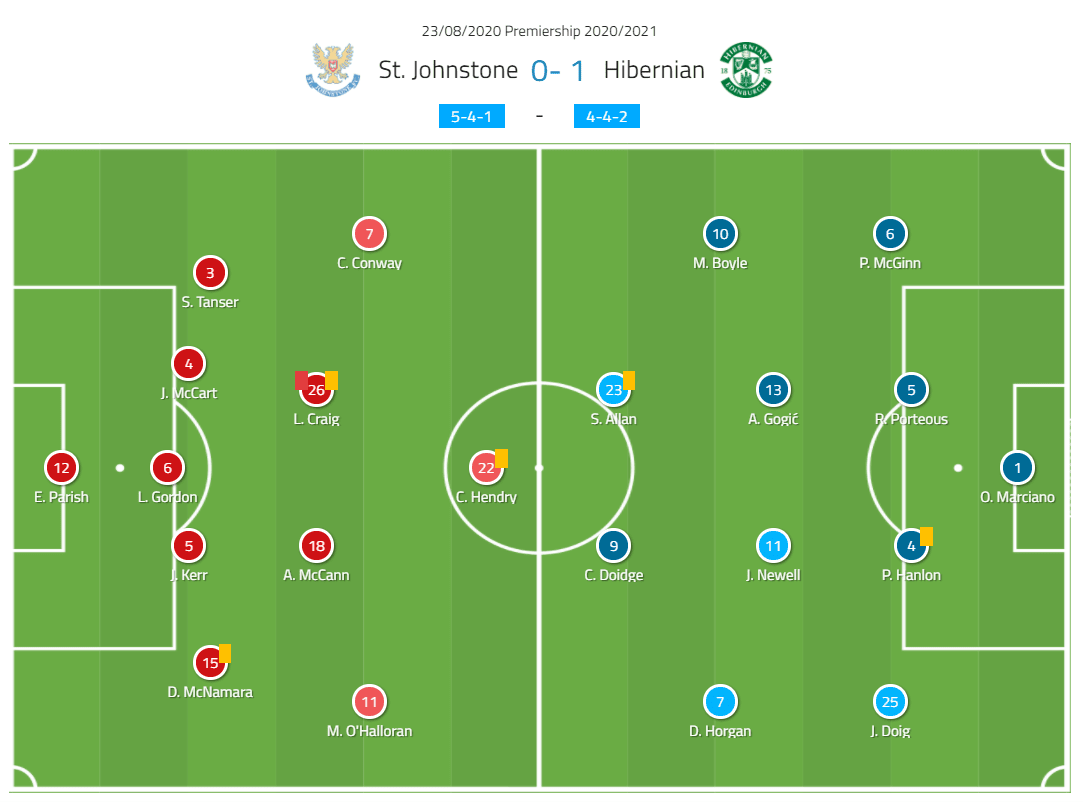
Davidson set up his side in a 5-4-1 that formed into a 3-4-3 formation at times. The Saints boss only made one change to his side that lost 0-1 to Aberdeen last Thursday. Craig Conway came in for the ex-Hibs midfielder David Wotherspoon who dropped to the bench against his old club. Davidson looked to add a fresh player to his three-man forward with Conway lining up on the left-wing supporting both Hendry and Michael O’ Halloran who lined up the opposite flank for this home game.
Jack Ross set up his side in a 4-4-2 shape which shifted early on to a 4-2-3-1 formation. The Hibs boss also only made a single change to his team that drew 0-0 with Motherwell at Easter Road last weekend. Scott Allan came in for the in-form new signing Kevin Nisbet who tweaked his hamstring and so dropped out of the squad travelling to Perth. The former EFL player played in the central attacking midfield position just behind Christian Doidge who now had to operate in the lone strikers’ role.
Hibs progress the ball forward centrally with ease to the final third
With Allan dropping back to midfield playing between the lines as aforementioned it gave Hibs the numerical advantage in the middle of the pitch creating a 3 v 2 with St.Johnstone’s central midfield pair. This numerical superiority in the central area aided Hibernian in the build-up phase as they looked to play out from the back.
It caused decisional problems for Ali McCann and Liam Craig who lined up in the middle for the Saints as to whether they should push up on Hibs’ double pivot to close these passing option’s off or drop back to close the space in a more advanced area between the lines which Allan had positioned himself in which to receive the ball.
This caused a vertical decision problem but Hibs also created horizontal problems for the two central midfielders as Allan kept drifting wide in the right half-space while on the opposite flank left midfielder Daryl Horgan tucked in off his wing to position himself in the left half-space which formed a 4 v 2 at times in the middle of the pitch as the Hibernian left-back Josh Doig pushed forward in order to keep the width of the left-wing pinning the St. Johnstone right wingback to ensure he could not follow Horgan into this position. We can see this illustrated in the example below.
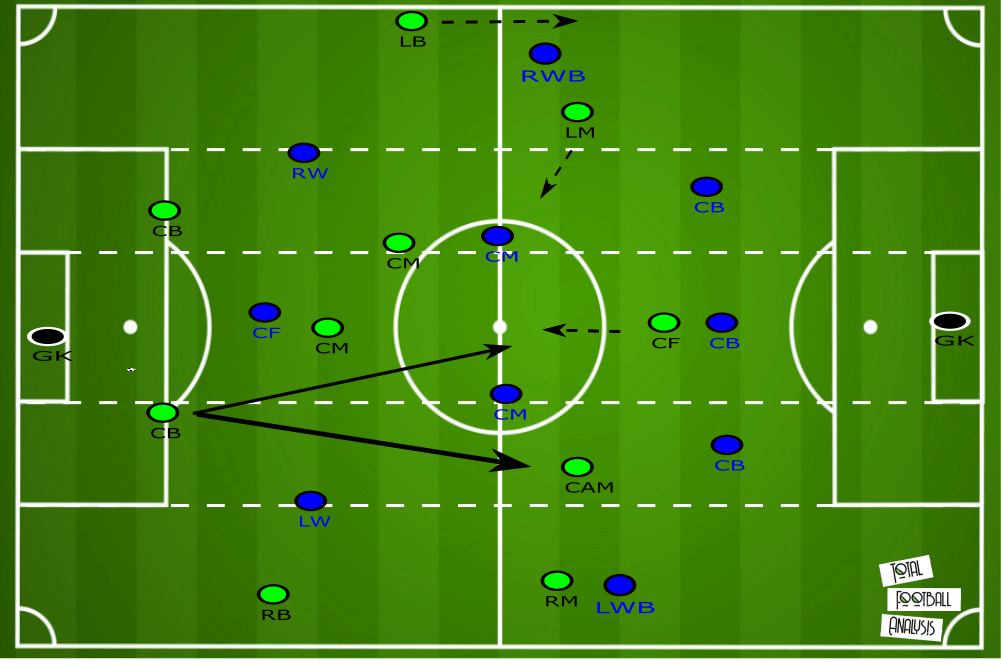
By creating these decisional problems in the middle when Hibs were building out from the back Jack Ross’s side could easily play past the first line of pressure by accessing one of their double pivots as a short passing option but also the Hibs centre-back had two more advanced options based on Hibs players creating horizontal decision problems by position themselves in the half-spaces as we see above.
Hibernian took advantage of these more advanced passing options as St. Johnstone’s midfield pair initially split wide to cut off the Hibs pair positioned in the half-spaces but this created large spacing in between the Saints pair opening up the middle of the pitch as a result and Hibernian’s striker Doidge could drop with a high to low movement down to receive the ball to feet in this area, as we can see below.
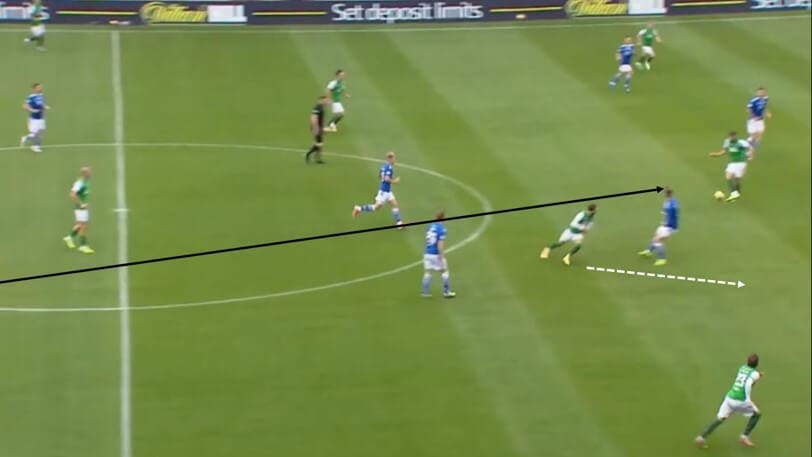
Hibs found joy from this specific sequence of play which was helped by how brave centre-back Ryan Porteous was with his passing as he split the first two lines of pressure as he found Doidge who was able to spin and lay the ball off to Martin Boyle making a run off the Welshman, creating their first attempt on goal.
The St.Johnstone midfield pair tried to rectify this and stop this avenue and began to close this large spacing between them by playing narrow shutting off the direct ball in the centre-forward but this action opened up more space to access the Hibs players operating in the half-spaces as we can see below as Ryan Porteous once again has possession and fizzes a pass forward to progress the ball.
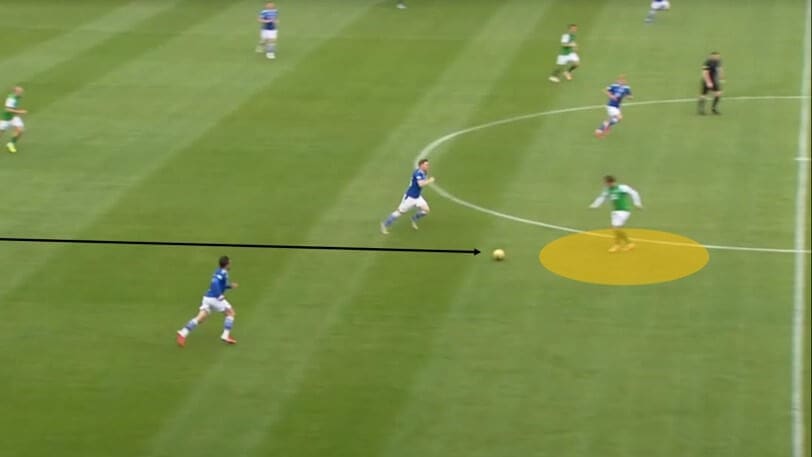
Scott Allan has drifted out to right-half space to receive the ball from his centre-back on the half-turn progressing up to the final third of the pitch. This also happened on the opposite flank, as we can see below, Joe Newell has dropped to receive the ball which acts as a trigger for left-back Doig to advance forward on the left-wing. This enables Daryl Horgan to tuck into the left-half space with nobody around him.
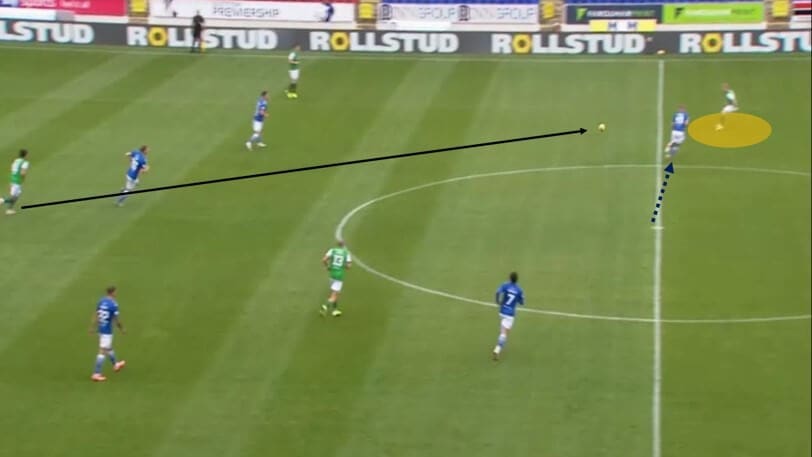
We also see Ali McCann is conscious of the large spacing that was getting exposed early so is too far away to cut off the passing lane and effect the play as Newell finds Horgan and he has the space to turn and drive forward. Hibs overwhelmed St. Johnstone in the middle of the park as they were able to progress the ball from back to front breaking multiple lines with their passes as they regularly converged on St. Johnstone’s backline.
The Saints eventually matchup with Hibs to stop their build-up play
Even though Hibernian were able to progress the ball easily up to the final third through the avenues mentioned above they were not able to break down St. Johnstone’s backline. Davidson’s side were well organised and resilient in defence showing great appetite to get numbers back and around the ball to ensure Hibs could not penetrate further.
We can see in the example below how Hibs again were able to access Doidge who looked to play the ball in behind for Boyle on this near side, however even with the wingers searing speed St. Johnstone defensive line is well-positioned to deal with him as the Hibs wide player who is isolated.
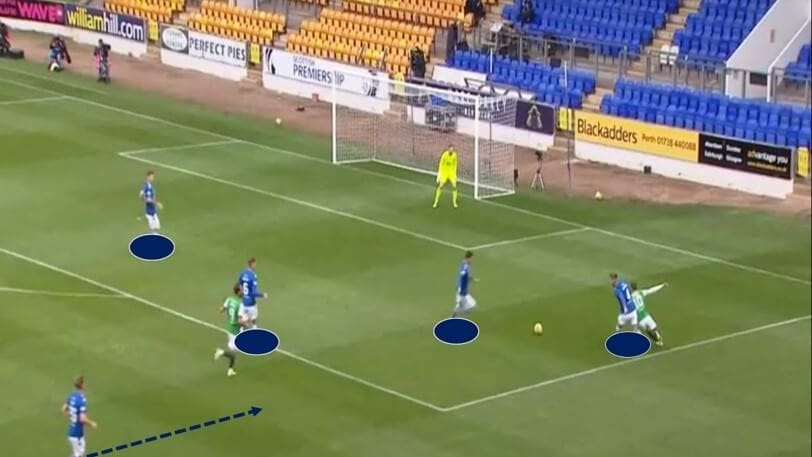
The Saints have got numbers back with four players protecting the area with another player dropping back against Hibs two attackers. Boyle tries to go by his man but is eased off the ball with a covering Saints teammate supporting inside to clear the ball away stopping Hibernian’s attacking efforts.
To ease the pressure that was applied on his backline Callum Davidson tweaked his side’s shape at the half-time break switching from a 3-4-3 to a 3-4-1-2 formation as left-winger Conway tucked into the centre behind the front two thus matching up with Hibs numerically in the middle as his task was to man-mark the ball near pivot dropping to receive the ball off his centre-back in Hibernian’s build-up.
This enabled the Saints midfield pair to stay deeper and collapse the space in-between the defence and the midfield lines while also being closer to the players operating in the half-space to effective the play better. This made it difficult for Hibs to build up so cleanly and progress the ball to the final third as the passing options that were once available in the first half were now being shut off. We can see how effective Davidson’s switch in shape was at disrupting Hibernian’s build-up play in the example below.
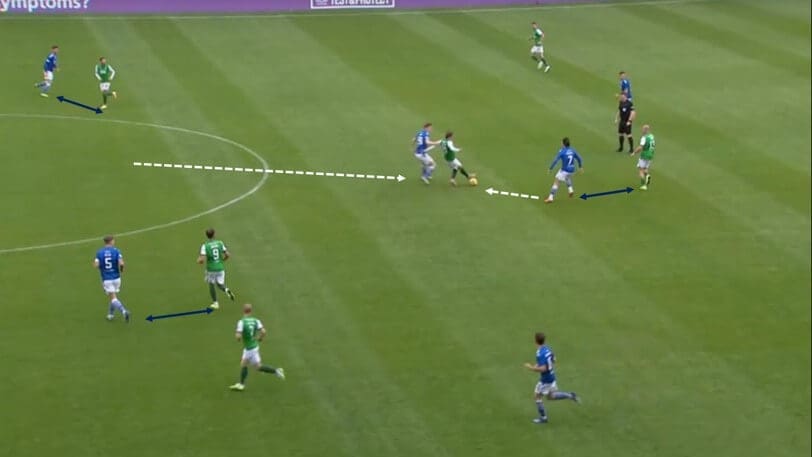
Hibs are trying to build-up from the back through their centre-backs who are trying to progress the ball forward centrally. However, Hibs’ short passing option is covered by Conway who is man-marking Alex Gogić and so the Hibs centre-back is forced to play the ball past Gogić into Allan who is looking to receive the ball.
However, from this change in shape in after the interval, Saints midfielder Craig is closer to the Hibs midfielder to affect the play as he presses him from behind, as we see above, which forces Allan into a heavy first touch right into the now congested middle of the pitch where Conway who is supporting Craig. Conway is close enough to the ball to win possession off Allan in an advanced position whilst also stopping Hibs build-up play at the same time.
St. Johnstone start to play on the front foot which results from this tactical change
In the first half St. Johnstone struggled to put any sustained passages of play together with Hibernian dominating proceedings as they enjoyed 60% possession. This scale of control was down to the fact they had extra players in central areas as previously outlined above. When St. Johnstone did win back possession it was deep in their own half and so in an attempt to get themselves up the pitch and relieve the pressure, their attacking strategy consisted of knocking long direct balls forward up to the isolated Saints forward Hendry.
The Saints forward with the support of right-midfielder Michael O’ Halloran at times did well and worked to win attacking set-pieces with one of these set-piece instances (second phase of an attacking corner) resulted in Hendry heading past the Hibs keeper but it was harshly ruled out. Overall though in open play, Hendry when he was able to hold up the ball in the first-half there was no support for him and he lacked options in the box when he won the ball down the channels on the wing, as we can see below.
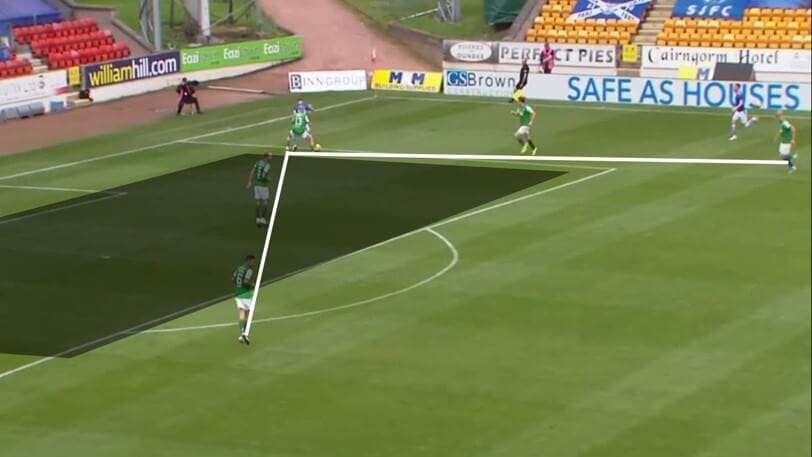
Hendry has won the ball at the edge of the box but he is totally isolated upfront. We can see that Hibs’ backline is not needing to pick up anybody inside the box, the only option the Saints forward has is to play the ball back to O’ Halloran on the same wing but he would also find it hard to muster up an attack with no St. Johnstone players providing an option inside the penalty area. St. Johnstone, therefore, did not really threaten Hibs in attack in the first half apart from the odd set-piece opportunity.
Davidson’s tactical change at the break as outlined in the previous point above was twofold as it disrupted Hibernian’s build-up play from a defensive point of view but from an attacking point of view, the Saints were also winning the ball much higher up than they were doing in the first half before this switch occurred. As a result of winning possession back deep in Hibs’ half while also employing a front two in the second half meant that St. Johnstone committed to getting more bodies to the box creating multiple options for the Hibs defence to now defend, as we can see in the example below.
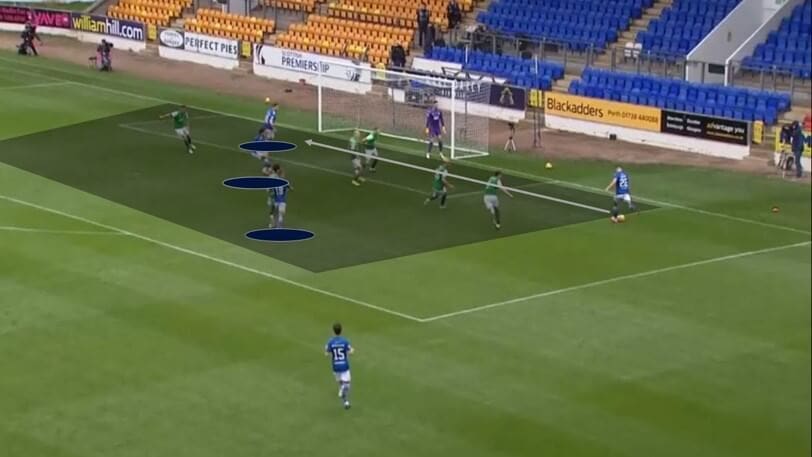
We see Hendry in a similar position to the previous image above however now he has much more support in attack and has multiple different options he can now pick from as there is one teammate is making a run to the front post, a teammate at the back post and a player who has just arrived into the box behind the play who could be a potential cutback option.
Hendry decides to pick out his teammate at the back post with a driven cross but Ofir Marciano in goals gets down well to stop the cross getting to the Saints player. This tactical change although St. Johnstone did not get the breakthrough goal but at least they were a threat in attack and asked more questions of the Hibs defence as they played more on the front foot as a result in the second half.
Conclusion
Callum Davidson’s side struggled in the first half of this game and suggested that his players were asleep after the game but truthfully the problem was down to how his side was set up at the start as they were overwhelmed in the central areas as Hibs had the numerical advantage as they enjoyed the majority of possession and they dominated the game up until the break.
It was only when Davidson addressed this problem after the interval where his side started to then control the game and add some attacking threat in open play. The game looked like it would end in a stalemate and with the Saints coming away with a least a point but in stoppage time they gave away a penalty as frustration continued to boil over after the final whistle as Liam Craig was shown a second yellow for arguing with the referee which sees him miss a big game against St. Mirren.
Jack Ross will be relieved that his side continues to pick up points without playing to their best as they scrapped by just as they did against Dundee United and now St. Johnstone. Hibernian go joint top with this result taking 13 out of possible 15 points available. Hibs will look to continue with this momentum they have built up and will hope to improve on their display as they face a rejuvenated Aberdeen side next.





Comments